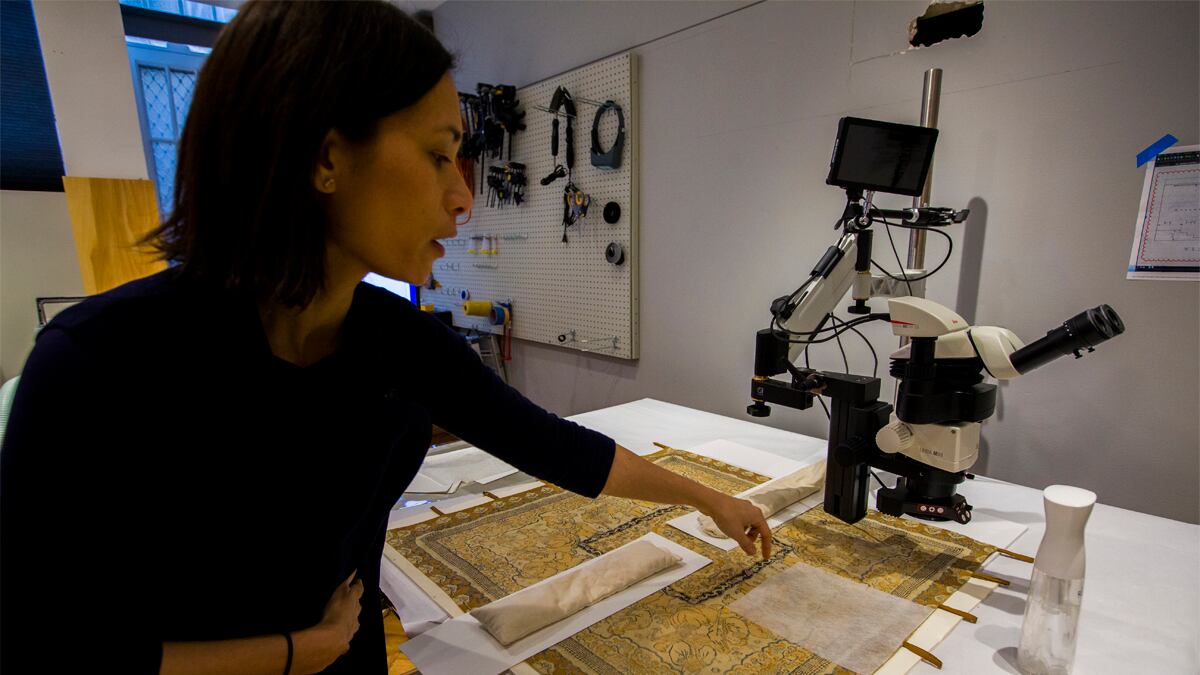The Portland Art Museum isn't sure why pieces of Egghead, an installation on the top floor of its contemporary wing, keep falling off. But whenever they do, Samantha Springer is the one to fix it.
"This is a problem piece," says Springer, who, as the museum's sole art conservator, does all the tedious, hands-on work of preserving and restoring pieces in the art institution's care.
Egghead is a portrait made up of crumbled lumps of synthetic resin meant to look like chewed gum. The museum can't tell whether visitors have been picking off the pebbled-sized clumps of resin or they've been falling off on their own.
There has been one clear incident of vandalism, though—a few weeks ago, protection services noticed a real wad of gum stuck to the fake wads of gum.
Springer—who came to PAM four years ago after working in museums across the country—has to plan most of what she does on a case-by-case basis. If she simply pulled off the gum, she would risk pulling off a piece of resin with it. Instead, she cut off most of the gum with a small scalpel and dissolved the rest with solvent.
Though the results appear unobtrusive and effortless, conservation is a complex field that requires an understanding of both art history and chemistry. It also requires patience and precision that can't be taught in a degree program.
"If something is extra difficult, you need a steady pair of hands," says Springer. "I don't know if it's something that you can achieve with practice."
Japanese Textile
In her airy lab, about the size of a high school classroom, Springer is currently working to remove creases from an 18th century Japanese textile. It can't just be ironed or steamed. Too much heat could cause the paint to bleed, and too much water might make dirt that's invisible to the naked eye migrate into wavy water lines. So Springer routinely applies blotter paper, moistened with just enough purified water to make the fibers relax. Then, she applies dry blotters weighed down with beanbags. Even for a process as seemingly inconsequential as removing wrinkles, Springer must photo-document everything she does and get her plan approved by the curator.
Tool Kit

Springer customizes just about everything she uses. "I don't trust anything you can buy in the store," she says. She mixes her own solvents and adhesives based on the sensitivity of each artwork and creates swabs by swirling tufts of cotton around bamboo skewers—even her magnifying glasses were painted purple by a friend. Most of her tools are meant to help her get into small spaces: One day, museum staff found a tiny piece of dust lodged between a frame and a painting. The debris was too stubborn for her brush, so Springer removed the single speck of dirt with tweezers.
Silver Collection

The art museum has a collection of over 100 tea sets, clocks, candlesticks and dining ware all made of silver, spanning continents and hundreds of years. Polishing it takes careful consideration. "Whenever you polish silver, you're actually removing some of the silver," says Springer. "So I don't take polishing silver lightly." She cleans each piece, then buffs it with polish she mixes herself and coats it with a clear compound to help prevent future tarnish. Deciding how much or how little to clean is its own careful process, determined after conversations with museum curators. "Whenever we're making a decision about restoring an object," says Springer, "we have to make a judgment about what point in time are you restoring an object to."
Backing on Untitled by Sally Haley

A year ago, Springer had to treat a 1959 modernist painting by the late Portland artist Sally Haley. The painting developed a white haze—probably from fat naturally released by the egg tempera over time—which she essentially dusted from the 8-square-foot surface with a small brush. She also constructed a backboard with polyester padding to help stabilize the canvas, mitigate fluctuations from changes in humidity and provide a cushion if it does move. Says Springer, "Those are some of the preventive measures that we do that no one will ever see."
Portland Art Museum Spring Highlights
Art and Race Matters: The Career of Robert Colescott, through May 17
Volcano! Mount St. Helens in Art, through May 17
In Dialogue: Satire in the Work of Robert Colescott with Broke Gravy, April 10
Precarious Places: Alternative Art Spaces PDX, May 30
Frida Kahlo, Diego Rivera, and Mexican Modernism, June 13-Sept. 17
Willamette Week's Spring Arts Guide 2020
In Eyrst's Studio, Local Rappers Pull All-Nighters, and There's Artwork by the Nirvana Baby

